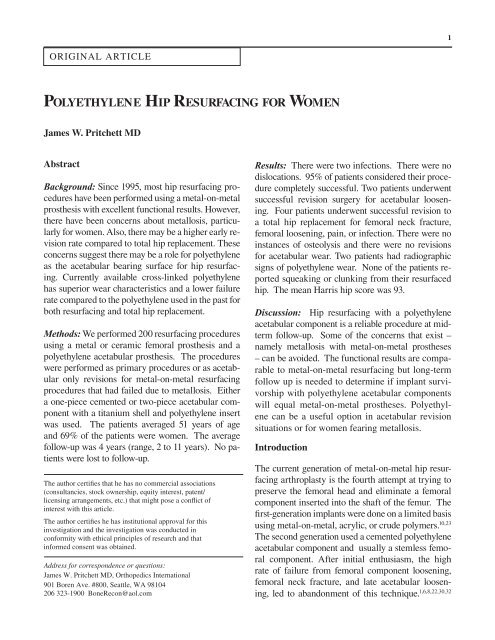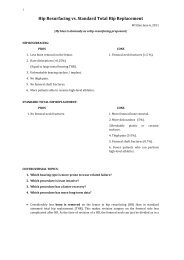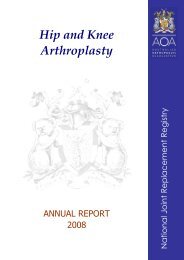Polyethylene Hip Resurfacing for Women by Dr. Pritchett
Polyethylene Hip Resurfacing for Women by Dr. Pritchett
Polyethylene Hip Resurfacing for Women by Dr. Pritchett
- No tags were found...
Create successful ePaper yourself
Turn your PDF publications into a flip-book with our unique Google optimized e-Paper software.
1ORIGINAL ARTICLE<strong>Polyethylene</strong> <strong>Hip</strong> <strong>Resurfacing</strong> <strong>for</strong> <strong>Women</strong>James W. <strong>Pritchett</strong> MDAbstractBackground: Since 1995, most hip resurfacing procedureshave been per<strong>for</strong>med using a metal-on-metalprosthesis with excellent functional results. However,there have been concerns about metallosis, particularly<strong>for</strong> women. Also, there may be a higher early revisionrate compared to total hip replacement. Theseconcerns suggest there may be a role <strong>for</strong> polyethyleneas the acetabular bearing surface <strong>for</strong> hip resurfacing.Currently available cross-linked polyethylenehas superior wear characteristics and a lower failurerate compared to the polyethylene used in the past <strong>for</strong>both resurfacing and total hip replacement.Methods: We per<strong>for</strong>med 200 resurfacing proceduresusing a metal or ceramic femoral prosthesis and apolyethylene acetabular prosthesis. The procedureswere per<strong>for</strong>med as primary procedures or as acetabularonly revisions <strong>for</strong> metal-on-metal resurfacingprocedures that had failed due to metallosis. Eithera one-piece cemented or two-piece acetabular componentwith a titanium shell and polyethylene insertwas used. The patients averaged 51 years of ageand 69% of the patients were women. The averagefollow-up was 4 years (range, 2 to 11 years). No patientswere lost to follow-up.The author certifies that he has no commercial associations(consultancies, stock ownership, equity interest, patent/licensing arrangements, etc.) that might pose a conflict ofinterest with this article.The author certifies he has institutional approval <strong>for</strong> thisinvestigation and the investigation was conducted incon<strong>for</strong>mity with ethical principles of research and thatin<strong>for</strong>med consent was obtained.Address <strong>for</strong> correspondence or questions:James W. <strong>Pritchett</strong> MD, Orthopedics International901 Boren Ave. #800, Seattle, WA 98104206 323-1900 BoneRecon@aol.comResults: There were two infections. There were nodislocations. 95% of patients considered their procedurecompletely successful. Two patients underwentsuccessful revision surgery <strong>for</strong> acetabular loosening.Four patients underwent successful revision toa total hip replacement <strong>for</strong> femoral neck fracture,femoral loosening, pain, or infection. There were noinstances of osteolysis and there were no revisions<strong>for</strong> acetabular wear. Two patients had radiographicsigns of polyethylene wear. None of the patients reportedsqueaking or clunking from their resurfacedhip. The mean Harris hip score was 93.Discussion: <strong>Hip</strong> resurfacing with a polyethyleneacetabular component is a reliable procedure at midtermfollow-up. Some of the concerns that exist –namely metallosis with metal-on-metal prostheses– can be avoided. The functional results are comparableto metal-on-metal resurfacing but long-termfollow up is needed to determine if implant survivorshipwith polyethylene acetabular componentswill equal metal-on-metal prostheses. <strong>Polyethylene</strong>can be a useful option in acetabular revisionsituations or <strong>for</strong> women fearing metallosis.IntroductionThe current generation of metal-on-metal hip resurfacingarthroplasty is the fourth attempt at trying topreserve the femoral head and eliminate a femoralcomponent inserted into the shaft of the femur. Thefirst-generation implants were done on a limited basisusing metal-on-metal, acrylic, or crude polymers. 10,23The second generation used a cemented polyethyleneacetabular component and usually a stemless femoralcomponent. After initial enthusiasm, the highrate of failure from femoral component loosening,femoral neck fracture, and late acetabular loosening,led to abandonment of this technique. 1,6,8,22,30,32
3Materials and MethodsFor hip resurfacing we offered a polyethyleneprosthesis to patients who had the following indications:(1) small femoral geometry (women),defined as a femoral head diameter of less than46 mm, (2) prior adverse reaction to metal weardebris, and (3) concern <strong>for</strong> metal sensitivity. Allpatients were also offered the option of total hipreplacement procedures. All patients were awareof the availability of metal-on-metal resurfacingprostheses.All femoral prostheses were stemmed and either amodular magnesia-stabilized zirconium or cobaltchromiumfemoral prosthesis was used (Figure 1) . Femoralprostheses were used with or without cement.The acetabular prostheses were either cemented inplace or implanted without cement. The cementlessprostheses were two-piece with a titaniumbacking and cross-linked polyethylene of a compositethickness of 10 mm.Patients were allowed full weight bearing immediatelyand were evaluated annually. No limitationswere placed on patients following their initial recovery.No blood transfusions were given.ResultsThe follow-up ranged from 2 to 11 years. Fortyfourpatients had 2 to 3 years of follow-up, 51 had8 to 11 years of follow-up, and 105 had 3 to 8 yearsof follow-up. No patients were lost to follow-up.There were 200 resurfacing procedures using apolyethylene acetabular prosthesis and a metalor ceramic femoral prosthesis per<strong>for</strong>med andprospectively followed. The average patient agewas 51 years and 69% of the patients were women.Of the 200 procedures, 158 were per<strong>for</strong>med asprimary procedures (Figures 2A, 2B) and 42 were acetabularrevisions <strong>for</strong> metal-on-metal resurfacing procedures(Figures 3A, 3B, 3C)that had failed due to metallosis.Figure 1. This is a photograph of the two-piece acetabularcomponent consisting of a porous titanium shell and a44 mm polyethylene liner. The femoral component iszirconium with a curved modular stem.For 179 procedures, a two-piece acetabular componentwith a titanium shell and a polyethylene insertwas used. For 21 procedures the polyethylenewas cemented to the acetabular bone.There were two wound infections and three patientsdeveloped substantial heterotopic ossification.There were no dislocations or nerve palsies.Five patients continued to report pain: two hadmild pain, two had moderate pain and one had substantialpain. Two patients, one with a cementedand one with a cementless acetabulum, underwentsuccessful revision <strong>for</strong> acetabular loosening. Four
4Figure 2A. This is an anteroposterior radiograph of a49-year-old woman with severe osteoarthritis.Figure 2B. The postoperative radiograph shows a hybridresurfacing using a two-piece acetabular component acemented cobalt-chromium femoral component.Figure 3A. This is a lateral radiograph of a 51-yearoldwoman who developed metallosis and acetabularloosening following a metal-on-metal resurfacingprocedure.Figure 3B. This is an anteroposterior radiograph after successfulrevision of the acetabular prosthesis to a two-piece polyethylenebearing prosthesis.
5patients underwent successful revision to total hipreplacement <strong>for</strong> femoral neck fracture, loosening,persistent pain, or infection.In three of the four revisions to total hip replacementprocedures, the metal backing of the acetabularcomponent was preserved and the acetabularliner was exchanged. In the fourth revision procedure,the cemented one-piece acetabular componentwas revised to a two-piece component. Therewas no appreciable wear at 2, 3, 5, and 6 years seenon the polyethylene.There were no instances of osteolysis but two patientshad radiographic signs of polyethylene wearat 7 and 8 years. (Figure 4A-B) No patients reportedsqueaking or clunking from their resurfaced hip.The mean Harris hip score was 93 and 95% of thepatients claimed no functional limitations.Figure 3C. This is a lateral radiograph after the acetabularrevisionDiscussion<strong>Polyethylene</strong> has been an orthopedicbearing material since the1960s. 5,14 It is chemically andconceptually simple; it is produced<strong>by</strong> the polymerization ofethylene gas into a macromolecularcarbon chain with pendanthydrogen atoms. Crosslinks,bonds that interconnectpolyethylene molecules, canbe produced <strong>by</strong> gamma or electronbeam radiation. They arethen annealed or re-melted <strong>by</strong>thermal treatments. 7 In 1998,highly cross-linked polyethyleneswere introduced <strong>for</strong> clinicaluse. Clinical studies to dateshow a 50% to 87% reductionin wear. 7,12,13Cross-linked polyethylene hasbeen produced and approved <strong>for</strong>use <strong>for</strong> femoral head diametersFigure 4A-B. This is an anteroposterior radiograph of a 44-year-old womanshowing a cemented polyethylene acetabular component and cobalt-chromiumfemoral resurfacing prosthesis. On the left, thinning of the polyethylene isseen 8 years following implantation. On the right, the original thickness of thepolyethylene is seen.
6up to 46 mm. Some, but not all, studies have shownincreased wear with femoral head diameters greaterthan 32 mm. There is substantial and favorableexperience with femoral head diameters of 36 and40 mm. 11,13,27 There is favorable wear simulatordata from polyethylene diameters of 44 and 46mm but no long-term clinical data are available. 11Limiting oxidation has been an additional concernand polyethylene containing Vitamin E is nowavailable. 4Early polyethylene prostheses were secured to thepelvis with polymethylmethacrylate during hip replacementor resurfacing procedures. 1,6,10,30,32 Thiswas very successful but late loosening is commonand, there<strong>for</strong>e, the use of porous-coated metalbacking had become a very popular and successfulalternative. Because cross-linked polyethylene canfracture, its thickness and the thickness of the metalbacking are subject to engineering limitations.Most engineers recommend using a polyethylenethickness of 3.8 mm or greater and a compositethickness including the metal backing of 10 mm ormore if a two-piece component is selected.Cobalt-chromium alloys are used widely as bearingsurfaces against polyethylene <strong>for</strong> hip and kneeimplants. Cobalt-chromium is harder and moreresistant to corrosion than previous metals usedin joint replacement, such as stainless steel. Titaniumis much too soft to use as a bearing surface.Cobalt-chromium surfaces can be damaged andexhibit low wetability. Newer cobalt-chromiumsurfaces are superior to older implants with respectto smoothness. Ceramic materials generally offerharder and more hydrophilic surfaces compared tocobalt chromium and can be polished to a very lowdegree of roughness. 14Alumina-based ceramics have very favorable wearcharacteristics but there have been rare reports ofimplant fracture. 29 Reports of yttria-stabilized zirconiashowed no reduction in wear when used withcross-linked polyethylene. 25 Oxidized zirconia hasfavorable wear results in hip simulator studies buthas not been manufactured <strong>for</strong> use in resurfacing. 3Magnesia-stabilized zirconia was chosen <strong>for</strong> use inour patients because of its superior wear characteristicsin a hip simulator. 25 Also, there was no difficultyin preparing thin-walled stemmed prosthesesappropriate <strong>for</strong> resurfacing applications. 21,27There are no long-term data available <strong>for</strong> usingcross-linked polyethylene <strong>for</strong> resurfacing applicationseither with cobalt-chromium or ceramic prostheses.A nitrated (ceramized) resurfacing prosthesishas been used on a limited basis articulatingwith non-cross-linked polyethylene. The durabilityhas been up to 11 years. 15<strong>Polyethylene</strong> should be reconsidered <strong>for</strong> resurfacingbecause of the superior wear characteristics ofcross-linked polyethylene. Also, newer cobaltchromiumprostheses have reduced roughness. Itwill take many years to confirm the wisdom of thisapproach. When polyethylene wear occurs, it isanticipated that revision to another polyethylenebearing without disturbing the well-fixed metalshell will be possible. <strong>Women</strong> need not be deniedhip resurfacing surgery.






